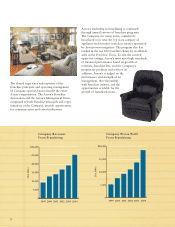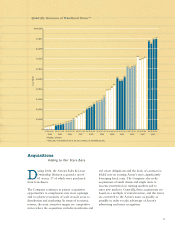Aarons 2004 Annual Report Download - page 20
Download and view the complete annual report
Please find page 20 of the 2004 Aarons annual report below. You can navigate through the pages in the report by either clicking on the pages listed below, or by using the keyword search tool below to find specific information within the annual report.
18
Commitments
Construction and Lease Facility. On October 31, 2001, we
renewed our $25 million construction and lease facility. From
1996 to 1999, we arranged for a bank holding company to
purchase or construct properties identified by us pursuant to
this facility, and we subsequently leased these properties from
the bank holding company under operating lease agreements.
The total amount advanced and outstanding under this
facility at December 31, 2004 was approximately $24.9
million. Since the resulting leases are accounted for as
operating leases, we do not record any debt obligation on
our balance sheet. This construction and lease facility expires
in 2006. Lease payments fluctuate based upon current
interest rates and are generally based upon LIBOR plus
1.1%. The lease facility contains residual value guarantee
and default guarantee provisions that would require us to
make payments to the lessor if the underlying properties
are worth less at termination of the facility than agreed upon
values in the agreement. Although we believe the likelihood
of funding to be remote, the maximum guarantee obligation
under the residual value and default guarantee provisions
upon termination are approximately $21.1 million and
$24.9 million, respectively, at December 31, 2004.
Leases. We lease warehouse and retail store space for
substantially all of its operations under operating leases
expiring at various times through 2019. Most of the leases
contain renewal options for additional periods ranging
from one to 15 years or provide for options to purchase the
related property at predetermined purchase prices that do not
represent bargain purchase options. We also lease transporta-
tion and computer equipment under operating leases expiring
during the next five years. We expect that most leases will be
renewed or replaced by other leases in the normal course of
business. Approximate future minimum rental payments
required under operating leases that have initial or remaining
non-cancelable terms in excess of one year as of December
31, 2004, including leases under our construction and lease
facility described above, are as follows: $50,676,000 in 2005;
$40,605,000 in 2006; $29,878,000 in 2007; $19,479,000 in
2008; $11,590,000 in 2009; and $23,549,000 thereafter.
We have 24 capital leases, 23 of which are with limited
liability companies (“LLCs”) whose owners include certain
Aaron Rents’ executive officers and controlling shareholder.
Eleven of these related party leases relate to properties
purchased from Aaron Rents in October and November
2004 by one of the LLCs for a total purchase price of
approximately $6.8 million. This LLC is leasing back
these properties to Aaron Rents for a 15-year term, with a
five-year renewal at the Company’s option, at an aggregate
annual rental of approximately $883,000. Another 11 of
these related party leases relate to properties purchased
from Aaron Rents in December 2002 by one of the LLCs
for a total purchase price of approximately $5 million. This
LLC is leasing back these properties to Aaron Rents for a
15-year term at an aggregate annual rental of approximately
$702,000. The other related party capital lease relates to
a property sold by Aaron Rents to a second LLC for $6.3
million in April 2002 and leased back to Aaron Rents for a
15-year term at an annual rental of approximately $681,000.
See Note D to the Consolidated Financial Statements. None
of the sale transactions resulted in any gain or loss in our
financial statements, and we did not change the basis of the
assets subject to the leases. These transactions were
accounted for as financings.
• proceeds from the sale of rental return merchandise
• private debt
• stock offerings
At December 31, 2004, $45.5 million was outstanding
under our revolving credit agreement. The increase in
borrowings is primarily attributable to cash invested in
new store growth throughout 2004. Our revolving credit
agreement provides for maximum borrowings of $87 million
and expires on May 28, 2007. We also have $50 million in
aggregate principal amount of 6.88% senior unsecured notes
due August 2009 currently outstanding, principal repayments
for which are first required in 2005. From time to time,
we use interest rate swap agreements as part of our overall
long-term financing program.
Our revolving credit agreement and senior unsecured
notes, as well as the construction and lease facility and
franchisee loan program discussed below, contain financial
covenants which, among other things, forbid us from
exceeding certain debt-to-equity levels and require us to
maintain minimum fixed charge coverage ratios. If we fail
to comply with these covenants, we will be in default under
these commitments, and all amounts would become due
immediately. We were in compliance with all of these
covenants at December 31, 2004.
We purchase our common shares in the market from
time to time as authorized by our Board of Directors.
As of December 31, 2004, our Board of Directors has
authorized us to purchase up to an additional 2,670,502
common shares.
At our annual shareholders meeting in May 2003, our
shareholders authorized an increase in the authorized number
of shares of Common Stock by 25 million shares for a total
of 50 million shares. The purpose of increasing the number
of shares of authorized Common Stock was to give the
Company greater flexibility in connection with its capital
structure, possible future financing requirements, potential
acquisitions, employee compensation, and other corporate
matters, including stock splits like the 3-for-2 splits
described below.
We have a consistent history of paying dividends, having
paid dividends for 18 consecutive years. A $.013 per share
dividend on Common Stock and Class A Common Stock was
paid in January 2004 and July 2004. In addition, in July
2004 our Board of Directors declared a 3-for-2 stock split,
effected in the form of a 50% stock dividend, which was
distributed to shareholders in August 2004. In August 2004
the Board of Directors also announced an increase in the
frequency of cash dividends from semi-annual to quarterly
basis. The first quarterly payment of $.013 per share on both
Common Stock and Class A Common Stock was distributed
in October 2004 for a total fiscal year cash outlay of
$2,042,000. A $.009 per share dividend on Common Stock
and Class A Common Stock was paid in January 2003 and
July 2003 for a total fiscal year cash outlay of $924,000 after
giving effect to a 3-for-2 stock split, effected in the form of a
50% stock dividend distributed to shareholders in August
2003. Subject to sufficient operating profits, future capital
needs, and other contingencies, we currently expect to
continue our policy of paying dividends.
We believe that our expected cash flows from operations,
existing credit facilities, vendor credit, and proceeds from
the sale of rental return merchandise will be sufficient to
fund our capital and liquidity needs for at least the next
24 months.
























